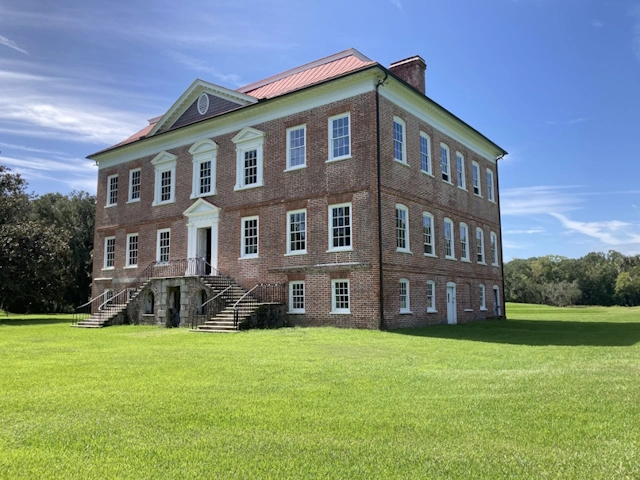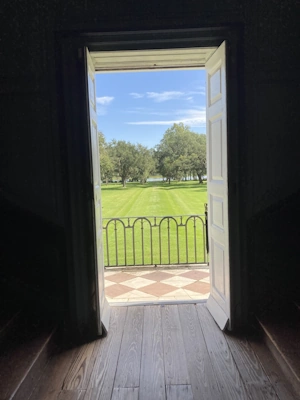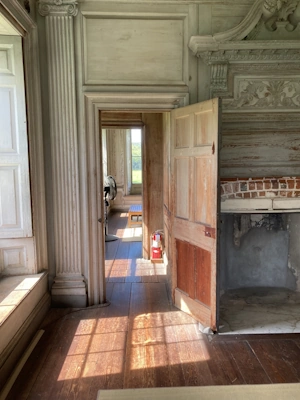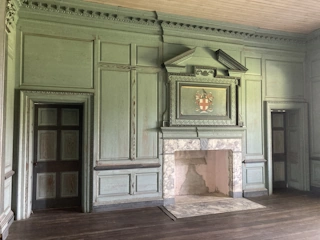Physical Address
304 North Cardinal St.
Dorchester Center, MA 02124
Physical Address
304 North Cardinal St.
Dorchester Center, MA 02124

Charlotta Drayton understood where she and her home fit into her family’s and her nation’s history. Born in 1884 into one of Charleston, South Carolina’s oldest and most influential families, she grew up listening to her parents and grandparents discussing the events in the history of her Drayton ancestors as if they were in yesterday’s newspaper. She grew to have a great deal of respect for her family and Drayton Hall on the Ashley River which had been the seat of the Drayton family since 1738.
By the time Charlotta was born in November 1884, the family owned three properties: Drayton Hall, a plantation located about 12 miles north of Charleston on the Ashley River, a large home at 25 East Battery Street built around the time she was born, and a summer home in Flat Rock, North Carolina where she died in 1969 at the age of 85.

Charlotta’s father, Charles Henry Drayton, 1847 to 1915, did well in the phosphate mining business which enabled he his wife Eliza, 1849 to 1926, to build a large home at 25 East Battery Street in downtown Charleston. Here they raised four children: Mary, Eliza, Charlotta, and Charles. This is where Charlotta spent most of time as a child and as an adult. But she also spent a good deal of time at Drayton Hall. As it turned out, Charlotta was the last family member to spend at least part of each year at her ancestral home.
Although Charlotta had a fine family home in Charleston, she decided at a young age that she would spend several weeks a year in the old family mansion. Being an attractive woman from an old wealthy family, she no doubt had many suitors hoping for her hand, but she chose to remain unmarried. Although she had a few good friends, she lived alone except for her cook, chauffer, and a few servants. She traveled extensively, painted in watercolors, and was an avid reader.
Did she have a sense that she was a bridge from the genteel days of Southern Aristocracy to the modern hustle bustle of a growing modern city? She lived at a tumultuous time when South Carolina was still recovering from the devastation of the Civil War, rebuilding after a large earthquake in August 1886, and trying to build a viable economy no longer based on slave labor.

Charlotta obviously thought about her ancestral home quite a bit and realized how important it was in her history as well as the history of her state and nation. She understood that Drayton Hall had to be preserved as it had been for almost 200 years. She determined that she would leave it architecturally undisturbed as a treasure for her family and America.
Drayton Hall had no electricity or plumbing, no central heat or air conditioning. To install these modern luxuries would mean boring holes through the old walls and disrupting the architecture of one of the most unique homes in America, a home that had survived battles during the American Revolution and the Civil War when many fine plantation homes around it were destroyed. Charlotta chose to do without these modern conveniences rather than disturb the integrity of the home that she loved and felt was unique in America.
Charlotta came from generations of people who influenced their times. The first Drayton in America was Thomas Drayton, Jr. who came from Barbados in 1679. Thomas met and married Ann Fox, daughter of Stephen Fox, one of Charles Towne’s first settlers in the early 1670s. Stephen owned land about 14 miles north of Charles Towne on the banks of the Ashley River which he passed to his daughter and son-in-law, and in 1700, the Drayton couple decided to build a home there. We know the area today as Magnolia Plantation.
Their son John Drayton was born there in 1715. Obviously, a precocious lad he attended school in England and developed interests in such fields as literature, astronomy, architecture, and natural history. While in England in 1733 John bought 47 original watercolor paintings from English ornithologist George Edwards who lived from 1694 to 1774. These priceless paintings were brought to America and 236 years later were discovered in the attic of the Drayton’s East Battery home in 1969.
In 1738 at age 23, John began construction of a home on family land south of Magnolia Plantation with John himself as the primary architect. He read several books on architecture and especially liked the work of Andrea Palladio, an Italian architect who lived from 1508 to 1580. The large structure took several years to complete but it was worth the wait. Today John’s home, Drayton Hall, is considered one of the finest examples of Palladian architecture in North America.
John was active in South Carolina politics and became a supporter of the American colonies break with England. As the British army was advancing toward Charles Towne (as Charleston was known at the time) in May 1779, John was forced to leave his home. While fleeing the army, he had a seizure in a boat near Strawberry Ferry on the Cooper River. He was taken to a nearby tavern where he died. Ownership of Drayton Hall passed to his sons.
The British army took Charles Towne and occupied the city from 1780 to 1782. For a while British general Charles Cornwallis made Drayton Hall his headquarters. Perhaps because of Cornwallis using the home, it survived the Revolutionary War relatively undamaged.
John’s sons became notable citizens. The oldest William Henry Drayton, born in 1742, to John’s second wife Charlotta, became an ardent patriot in the years leading up to the American Revolution. It was reported that on November 11, 1775 William, aboard the ship Defense, shot at the British ship Tamar in Charleston Harbor, thus initiating hostilities in South Carolina. He went on to serve in the Continental Congress and died in Philadelphia in September 1779 at the age of 36. He and his father died within a few months of each other.
Another of John Drayton’s sons, Charles Drayton, was born at Drayton Hall on December 22, 1743, just eight days before the death of his mother, Charlotta at age 24. Like Willam, Charles was educated in England and went on to earn a medical degree from University of Edinburgh in 1770. Upon returning home he joined William and his father in supporting the American cause against England. When war broke out, he was appointed a captain in the Continental Army.
After the war Charles worked at his medical profession and delved into botany as many physicians did in his day since a variety of plants were used for their curative effects. In this work he worked closely with French botanist Andre Michaux who maintained a large garden in Charleston for several years. He was also acquainted with Thomas Jefferson who sent him 118 olive tree seedlings from France. Charles had moderate success with the olives, but the climate in Charleston proved a bit too harsh for the trees to flourish. Charles made several structural improvements to the house and grounds at Drayton Hall and for a while grew cotton there. He died in September 1820 at the age of 76.
Another notable Drayton was John Drayton II, son of William Henry Drayton and grandson of the John who built Drayton Hall. Educated at the College of New Jersey, now Princeton University, he lived from 1766 to 1822 and served two terms as governor of South Carolina –1801 to 1803 and from 1808 to 1810. He was instrumental in founding South Carolina College, now the University of South Carolina, and later was a Federal District judge in South Carolina. He and his wife Hester had seven children.
There were other Drayton’s who through the centuries made significant contributions to the political, social, and military history of America that Charlotta would have known about. No doubt, her respect for these people who were her blood kin added to her desire to care for her family’s ancestral home.
Although Charlotta lived most of the year at the town home, every April she packed a few clothes and was driven by her chauffeur to Drayton Hall where she stayed for several weeks. Apparently, in spite of her social standing as a member of one of Charleston’s oldest and most prestigious families, she did not mingle a great deal with the social crowd. She had a few friends, but it was said that she stayed home most of the time, read a lot and took care of her dog Nipper, an English bull terrier that lived from 1914 to 1925 and was buried at Drayton Hall.

She also traveled quite a bit, and picked up the ritual of tea time in England. She got in the habit of having afternoon tea nearly every day at both Drayton Hall and 25 East Battery.
Her greatest contribution to Drayton Hall and to posterity is that she preserved it as it had been for centuries. She had one line of electricity run to the house for a hot plate and refrigerator but no extensive electrical work or plumbing. She used oil lamps for light and used the outdoor privy.
When she died in 1969, she left the property to her nephews, Frank and Charles. The brothers kept the property up as well as they could but it turned out that the old house needed structural work that was going to be expensive. After turning down an offer from a developer to turn the grounds into a golf course and the house a clubhouse, in 1974 Frank and Charles decided to sell the property to the National Trust for Historic Preservation.
It has turned out to be a great move for the brothers and especially for the rest of us. It was arranged that Frank and Charles would be able to enjoy the house as it was being studied and preserved by National Trust personnel. Frank died in 1979 and Charles lived until 2019, but both lived long enough to see that the house was going to become a national treasure to be enjoyed by thousands of people, especially by the many current Drayton family members and their descendants.
Another important thing the National Trust has helped bring about is promoting the importance of the African American influence on Drayton Hall. South Carolina’s first Drayton, Thomas Drayton, Jr., likely brought slave laborers with him form Barbados in 1679. When his son John built Drayton Hall, no doubt slave labor was essential in every aspect of the project from cutting the timber to firing the bricks, to the actual construction of the building.
Over the next years, slave labor became so important to the economic well-being of the planter class of the southern states that it took being defeated in the Civil War for the South to give it up. It is a sad legacy based on perceived economic necessity.
Unlike some slave owning families, apparently the Drayton’s maintained a good relationship with their black workers before and after the Civil War. Even after being freed, many of the formerly enslaved persons stayed on the Drayton plantation grounds and in their ancestral homes. Today their descendants attend the various functions held on the property each year and are recognized for their invaluable contributions in helping to build and maintain the grounds and the fine home. An important sign of the continuity of generations is that the centuries old African American cemetery on the property is still being used today.
Perhaps one of Drayton Hall’s most important legacies is that for many years it has served as a tangible bridge between the old aristocratic plantation South and the modern South where slavery is considered an unpleasant relic of the past.
Charlotta’s foresight in not modernizing Drayton Hall has allowed it to remain an architecturally and archaeologically significant time capsule that today is studied and analyzed as much as any historic site in America. The National Trust for Historic Preservation has put together a skilled and dedicated team from management to grounds keepers who understand the cultural, historical, and social importance of the Drayton property. The property is well cared for.
Thanks to John Drayton who built Drayton Hall, to the family members who maintained it over the years, to Charlotta who understood the need to preserve it, and thanks to Frank and Charles who were willing to allow it to go from the ownership of one family to become a part of America’s wide national fabric, the world has access to this unique property.
Ted McCormack